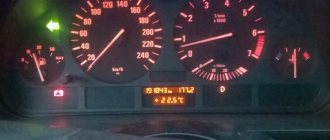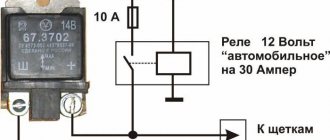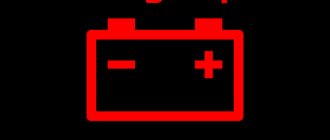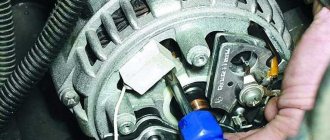It's no secret that when you turn the ignition key, the car's dashboard greets us with a number of flashing indicators and warning lights. All of them, to one degree or another, tell us about the serviceability of the on-board systems and the readiness of the engine to start. One of the most noticeable indicators is the red battery icon. If there are no problems, the pictogram will light up when the ignition is turned on and will immediately go out when the engine starts. This moment indicates that the battery is being charged from the generator. But now we’ll talk about what to do and where to run if this indicator does not go out or suddenly lights up on the road.
A little technical educational program: why the problem occurs
When the car is running, the battery is constantly recharged from the generator with a voltage of 13.6–14.2 volts. As the speed increases, the output voltage of the generator also increases, which can lead to negative consequences and damage to the battery. To solve the issue, a relay regulator or, more simply put, a voltage stabilizer is built into the circuit, reducing the current to the required values.
The battery is not charging light is on
As a result, we have a stable voltage charging of your car battery. And if the battery charge light comes on on the instrument panel, this means that the battery is not receiving charging from the generator.
After the ignition is started, voltage is first supplied through the fuse to the battery charge warning lamp. After which a voltage of 12 V passes through the diode, voltage stabilizer, brush, slip ring and winding. Further, the faster the rotor rotates, the more the phase voltage increases. This leads to equalization of the voltage at the contacts of the signal light, after which it goes out, thereby indicating that the battery is charging properly.
Generator connection diagram for VAZ 2105
Diode bridge
Placed on the back surface of the generator, it is responsible for converting alternating current. Common faults include breakdown and breakage.
To clarify, check the bridge with a multimeter, placing one probe on terminal 30 of the generator, and the second on the housing. The resistance of a working bridge tends to infinity. First make sure that there is no short circuit in the circuit.
If the battery charge light comes on while on the road
You are driving quietly and not bothering anyone, when in the most unexpected way (as always, however), the battery icon on the panel lights up in red. This is a signal that your car’s generator is faulty and has stopped providing current for recharging, so that all electrics now “sit” only on the battery.
What we may encounter in this case:
- The generator belt has broken. Electricity is generated during the rotation of the generator axis. This axis is driven by a belt. So if the belt breaks, the generator shaft stops rotating and the generation of electricity stops. And this leads to the battery charge lamp on the dashboard coming on.
- The voltage stabilizer on the generator has failed. Everything is simple here. The part is covered with a copper basin, and again we are not receiving the required voltage to the battery. The issue is resolved by replacing the failed element.
- Severe wear on the generator brushes. The generator shaft is equipped with graphite brushes that help generate electricity. Over time, they can wear out greatly, which will lead to a decrease in the electricity generated and the red battery icon on the device will light up. It is also necessary to replace worn components with new ones.
The list of possible reasons is, of course, not entirely complete. The most critical ones are given. Sometimes there may also be problems with diodes, oxidized terminals and contacts, problems with the fuse or ground wire contact.
Design of generators on VAZ cars
Generator brushes
The brushes receive current and transfer it to the battery. Although the parts are small, they are very important because they ensure the car’s performance. I make them from graphite, sometimes impregnated with a special solution for long-term operation.
To identify malfunctions, remove the brush assembly and inspect it. Opal marks and other characteristic signs indicate worn parts. Brush failure is also caused by mechanical wear. To do this, measure the height of the graphite elements. Replace the part immediately if the height is less than 5 mm.
On old foreign cars and domestic cars, brush problems are checked using a different method. With the engine running, remove the minus from the battery. If the motor continues to run, everything is in order, the brushes supply voltage.
What to do if the charging light is on
It will be quite difficult to cope with the above malfunctions somewhere along the way, except that the alternator belt can be changed if you suddenly always carry a spare one with you.
But not everything is so scary, and even with the battery charge lamp on, you are quite capable of continuing to move. The role of the power source will simply fall entirely on the shoulders of the battery. Nevertheless, even without recharging the battery, you can travel a sufficient distance if you follow these simple, but necessary in this case, recommendations:
- You shouldn’t turn off your car’s engine without a compelling reason. The fact is that when starting, the starter consumes quite a lot of electricity. So, in case of a forced stop, you should then start using the traditional method - “from the pusher”.
- It is better to refuse to include additional elements that consume electricity. Yes, without music, a heater, heated mirrors and rear window, driving will be noticeably less comfortable. But it’s better than getting stuck somewhere in the cold in the middle of the highway.
- It is also better to refuse to turn on fog lights and high beams at night.
- To prevent the battery from being powered by a faulty generator, it is better to immediately disconnect the wires coming from it and wrap them with insulation.
By following these simple tips, you can easily get to the nearest car service center or your home garage.
The battery lack of charge indicator lights up on the panel
Lost contact at battery terminals
At this diagnostic stage, you need to check the condition of the wire terminals and battery contact terminals. Often they oxidize, as a result of which the contact between them weakens. In the case when the battery light is on, but there is charging, this malfunction is most often the cause.
The generator operates normally, voltage is supplied to the terminals, but is lost due to poor contact. So it turns out that charging is in progress, but the battery charging light is on. Moreover, in most cases it burns with a dim light. This type of malfunction can be eliminated by cleaning the terminals and contact terminals of the battery, as well as treating them with a water-repellent liquid.
List of the most frequently asked questions about the problem
There are many additional questions related to the operation of the battery charge lamp. So, if the lamp:
“Lights up when the turn signal is turned on”
This point is mainly characteristic of VAZ classics. For the most part, people recommend not to bother and to continue driving calmly, since in general the system is working properly. But those who did not give up found the problem in a faulty diode bridge, some cleaned the contacts, some recommended checking the fuses, and some simply changed the lamps. No one can say for sure what will happen in your case.
"It's burning full"
Here, the first thing they recommend is to look at the diode bridge, then you can look at the generator brushes and check the ground. Although some people were even recommended to drop WD-40 into the ignition switch, the key allegedly does not return. And it helped!
“It lights up periodically at idle, low/high speeds”
First, you should check the generator belt and its tension, then you can blame the diode bridge and the voltage regulator. In the case of high speeds, the whole issue may also be due to the tired state of the generator brushes.
"Blinking"
In this case, the cause must be sought in oxidized or clogged contacts (including those on the battery) and connectors. So we look, search and clean. The voltage regulator may also be faulty. It is also worth checking the fuses and diode bridge.
"Comes on when the engine is cold"
This phenomenon often signals the need to replace the battery.
Here the cause may be the battery, because after a cold start it will consume more current than usual, therefore a voltage drop may occur, especially if the battery is “dead”. Or it could be a matter of poor contacts or even a tension belt, which may initially slip due to antifreeze or some other liquid getting on it.
“Starts to burn when the headlights are on”
We are looking for possible problems in the diode bridge and at the same time checking the generator brushes for wear.
"It stays on even though the ignition is off"
Perhaps a breakdown of the diodes, another reason could be a malfunction in the ignition contact group and even an installed abnormal alarm system.
“It’s on, but it’s charging!”
The reason here may be a breakdown of additional diodes on the diode bridge. It also happens that the reason is a faulty voltage regulator. These moments are especially characteristic of our classics. However, the problem may also be a bad mass due to oxidized and rusted contacts on the machine body. The solution in this case is to transfer the mass from the battery directly to the starter.
As is easy to see, in the vast majority of situations described, the problem is almost always on the surface. Either there is something wrong with the contacts, or the fuse is blown, or the diode is broken, or the voltage stabilizer is faulty.
Causes
If the system is working properly, the light will light for a short time and then go out.
The cause of the malfunction is checked according to a certain scheme. As a rule, the problem lies in a malfunction of the generator or battery, so the test starts with them.
| Light bulb illumination option | Cause |
| Doesn't go out | Generator, battery |
| Lights up intermittently | Loose alternator belt, poor output contact |
| Dim | Wiring |
| Flashing | Battery, wiring, ground |
| Lights up at low speed, then goes out | Battery terminals, brushes, relays, alternator belt |
| After re-gassing | Diode bridge |
| When driving | Damaged battery, brushes, ground |
If the indicator lights up while driving, it is recommended to drive to a repair site or a parking lot, since there is a high probability that you will not start the car after stopping.
Self-diagnosis of systems responsible for battery charging
Minimum required set of tools:
- 12 V indicator light;
- a pair of screwdrivers (both flat and Phillips);
- knife and pliers;
- sandpaper for possible cleaning of contacts;
- multimeter
Basic functions and capabilities of the multimeter
Below is a plan for self-diagnosis and identification of possible defects in the operation of the battery charging system. Along the way, attention will be focused on points indicating wear and failure of a particular component/part.
- First of all, we look at the generator fuse.
- The next step is to check the generator rotor windings for short circuits or breaks. To do this, we attach the clamps of a multimeter switched to measuring resistance to the slip rings. Acceptable numbers can be considered a range from 1.8 to 5 ohms. It shows less - you have a short circuit in the turns, a clear increase is visible - which means there is a direct break in the winding.
- Checking the belt for integrity and tension. Low output of the generator may well be due to weakened tension of the drive belt. A clear indication of this will be a clearly audible whistle when you sharply press the gas pedal or accelerate.
- Visual inspection of the wiring to identify insulation damage and burnout.
- You need to run your eyes over the body of the generator itself - suddenly there are cracks, damage and whatnot.
- Checking the slip rings and brushes of the generator. As you already know, brushes can wear out and even warp during use. Along with this, the grooves of the slip rings can become clogged with graphite dust over time. The evidence here would be excessive sparking.
- The bearings will also need to be checked. You will need to pay attention to them if your generator begins to whistle and hum noticeably loudly.
- Determining possible stator failure. To properly check the winding of the latter, it is necessary to disconnect it from the voltage stabilizer. If a multimeter switched to measuring resistance produces a value that goes to infinity, then we can say that the stator windings do not have proper contact with the body (ground).
- Checking the diodes in the voltage stabilizer. This operation also requires a multimeter. First, for example, the positive clamp clings to the “+” or “–” of the stabilizer, and the negative clamp to the phase output. Then you just need to swap the clamps. And if during these operations the readings on the multimeter differ noticeably, then the diode is not problematic, but if not, then it is faulty. Also, oxidized contacts indicate the imminent failure of the diode bridge.
Checking the operation of the generator with a multimeter (video)
Fuse failure
The electrical charging circuit of the battery, like any other, is protected by a fuse. It is located in the mounting block under the hood of the car. In “sixes” and “sevens” this fuse is usually designated as F10, but, in any case, it is better to look through the user manual before checking. Most often, when it malfunctions, no voltage is supplied to the battery at all, but it also happens that it is the reason why the battery charging light is on, but there is charging.
The fuse is checked with a tester after it is removed from the socket. If the device shows that the part has become unusable, simply replace it.











